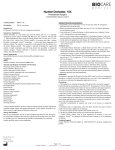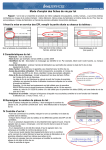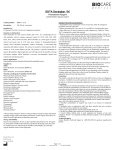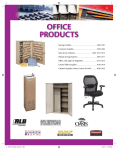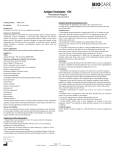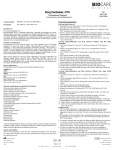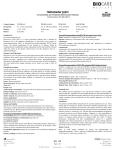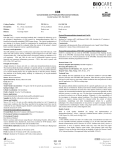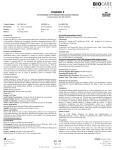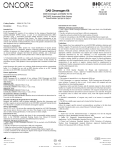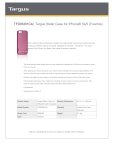Download Data Sheet
Transcript
Nuclear Decloaker, 10X Pretreatment Reagent Control Number: 901-CB911-013015 Catalog Number: CB911 M Description: 500 ml; concentrate Intended Use: For In Vitro Diagnostic Use Nuclear Decloaker, 10X is a buffered solution that is intended for laboratory use in heat-induced antigen retrieval of formalin-fixed paraffin-embedded (FFPE) tissues for immunohistochemistry (IHC) procedures. The clinical interpretation of any staining or its absence should be complemented by morphological studies using proper controls and should be evaluated within the context of the patient’s clinical history and other diagnostic tests by a qualified pathologist. Summary & Explanation: Nuclear Decloaker is a Tris buffer heat retrieval solution, pH 9.5. It is specially designed for nuclear antigens including ER, PR, Ki-67, p53, cyclin D1, TdT and TTF -1. Other antibodies that show improved staining include ALK1, ALKc, bcl-2, CA125, CD3 (M), CD15, CD30, CD31, CD79a, MART-1, Tyrosinase and Villin. Nuclear Decloaker incorporates Assure™ technology, a color-coded high temperature pH indicator solution. The end-user is assured by visual inspection that the solution is at the correct dilution and pH. This product is specially formulated for superior pH stability at high temperatures and will help prevent the possibility of losing pH sensitive antigens. Nuclear Decloaker is non-toxic, non-flammable, odorless and sodium azide and thimerosal free. Known Applications: Immunohistochemistry (formalin-fixed paraffin-embedded tissues) Supplied As: 500ml Nuclear Decloaker, 10X concentrate (CB911M) ISO 9001&13485 CERTIFIED Protocol Recommendations: 1. Deparaffinize tissues and hydrate to water. If necessary, block for endogenous peroxidase and wash in DI water. 2. Dilute concentrate Nuclear Decloaker at a ratio of 1:10 (1 ml Nuclear Decloaker to 9 ml deionized water) 3. Place slides into 1X retrieval solution in a slide container (e.g. Coplin jar, TissueTek™, staining dish or metal slide canister). 4. Retrieve sections under pressure using Biocare’s Decloaking Chamber. Follow the recommendations on the antibody data sheet and Decloaking Chamber User Manual. 5. Check solution for appropriate color change. (See Technical Note #1) 6. Gently rinse by gradually adding DI water to the solution, then remove slides and rinse with DI water. Technical Notes: 1. Concentrated Nuclear Decloaker is a bright fuschia red color. RTU or 1X solution is pale fuschia color. When the solution reaches 80-125°C, the solution stays fuschia red and indicates that the high temperature solution is at correct pH. If the solution turns orange or yellow, the pH of the buffer is incorrect. 2. If using Biocare's Desert Chamber Pro (a programmable turbo-action drying oven), dry sections at 25°C overnight or at 37°C for 30-60 minutes and then dry slides at 60°C for 30 minutes. 3. Use positive charged slides (use Biocare's Kling-On HIER Slides) and cut tissues at 4-5 microns. Do not use any adhesives in the water bath. Poor fixation and processing of tissues will cause tissue sections to fall off of the slides, especially fatty tissues such as breast. Tissues should be fixed a minimum of 6-12 hours. 4. Protocol time and temperatures for HIER can vary depending on the Decloaking Chamber model used. Please refer to the relevant Decloaking chamber manual for appropriate protocol times and temperatures. Limitations: The protocols for a specific application can vary. These include, but are not limited to: fixation, heat-retrieval method, incubation times, tissue section thickness and detection kit used. Due to the superior sensitivity of these unique reagents, the recommended incubation times and titers listed are not applicable to other detection systems, as results may vary. The data sheet recommendations and protocols are based on exclusive use of Biocare products. Ultimately, it is the responsibility of the investigator to determine optimal conditions. The clinical interpretation of any positive or negative staining should be evaluated within the context of clinical presentation, morphology and other histopathological criteria by a qualified pathologist. The clinical interpretation of any positive or negative staining should be complemented by morphological studies using proper positive and negative internal and external controls as well as other diagnostic tests. Materials and Reagents (Needed But Not Provided): Microscope slides, positively charged Desert Chamber* (Drying oven) Positive and negative tissue controls Xylene (Could be substituted with xylene substitute*) Ethanol or reagent alcohol Decloaking Chamber* (Pressure cooker) Deionized or distilled water Wash buffer*(TBS/PBS) Enzyme digestion* Avidin-Biotin Blocking Kit*(Labeled Streptavidin Kits Only) Peroxidase block* Protein block* Primary antibody* Negative control reagents* Detection kits* Detection components* Chromogens* Hematoxylin* Bluing reagent* Mounting medium* Quality Control: Refer to CLSI Quality Standards for Design and Implementation of Immunohistochemistry Assays; Approved Guideline-Second edition (I/LA28-A2). CLSI Wayne, PA, USA (www.clsi.org). 2011 * Biocare Medical Products: Refer to a Biocare Medical catalog for further information regarding catalog numbers and ordering information. Certain reagents listed above are based on specific application and detection system used. Storage and Stability: Store at room temperature. Do not use after expiration date printed on vial. If reagents are stored under conditions other than those specified in the package insert, they must be verified by the user. Diluted reagents should be used promptly; any remaining reagent should be stored at room temperature. Precautions: 1. This product is not classified as hazardous. The preservative used in this reagent is Proclin 300 and the concentration is less than 0.25%. Overexposure to Proclin 300 can cause skin and eye irritation and irritation to mucous membranes and upper respiratory tract. The concentration of Proclin 300 in this product does not meet the OSHA criteria for a hazardous substance. Wear disposable gloves when handling reagents. 2. Specimens, before and after fixation, and all materials exposed to them should be handled as if capable of transmitting infection and disposed of with proper precautions. Never pipette reagents by mouth and avoid contacting the skin and mucous membranes with reagents and specimens. If reagents or specimens come in contact with sensitive areas, wash with copious amounts of water. Page 1 of 2 Nuclear Decloaker, 10X Pretreatment Reagent Control Number: 901-CB911-013015 Precautions Cont'd: 3. Microbial contamination of reagents may result in an increase in nonspecific staining. 4. Incubation times or temperatures other than those specified may give erroneous results. The user must validate any such change. 5. Do not use reagent after the expiration date printed on the vial. 6. The SDS is available upon request and is located at http://biocare.net/. 7. Consult OSHA, federal, state or local regulations for disposal of any toxic substances. ProclinTM is a trademark of Rohm and Haas Company, or of its subsidiaries or affiliates. Troubleshooting: Follow the antibody specific protocol recommendations according to data sheet provided. If atypical results occur, contact Biocare's Technical Support at 1-800-542-2002. Page 2 of 2 ISO 9001&13485 CERTIFIED


